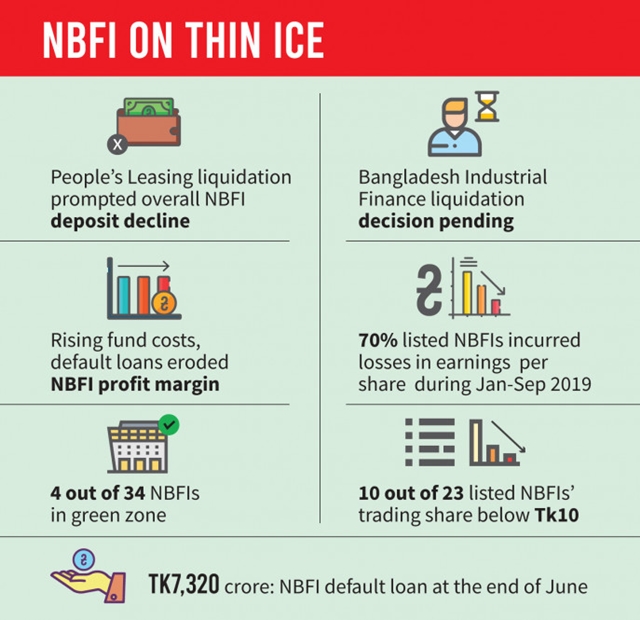SAM
Published:2019-11-14 02:32:46 BdST
People’s Leasing collapse adds to woes of NBFIs
FT ONLINE
The collapse of two non-bank financial institutions (NBFIs) has had an adverse impact on the whole industry. It has predictably pushed profitability down to the bottom.
In the first nine months of the current year, as much as 70 percent of listed NBFIs went through a severe decline in financial performance, leading to losses in earnings per share.
Of the 23 companies listed with the Dhaka Stock Exchange (DSE), only eight saw an improvement in profits in the period January-September this year.
The worsening financial performance of the companies pushed the profitability indicators of NBFI market into negative territory.
In the January-March quarter, returns on assets and returns on equity were a negative 0.1 percent and 0.5 percent respectively. But in the April-June quarter, the indicators showed a positive trend again.
However, overall deposits continued to decline in the NBFI sector amid the pressure of funds withdrawal after People's Leasing was put on liquidation, thereby intensifying the liquidity crisis.
NBFI deposits declined by 2.7 percent in the April-June quarter in comparison with the previous quarter, according to data made available by Bangladesh Bank.
On June 27 this year, the Finance Ministry gave its nod to Bangladesh Bank's decision to liquidate People's Leasing. The fate of another company, Bangladesh Industrial Finance (BIFC), remained pending with the ministry for a decision or otherwise on liquidation.
The rising cost of funds amid an intense deposit crisis in the aftermath of the fall of People's Leasing and the precarious condition of Bangladesh Industrial Finance Corporation (BIFC) has eroded the profit margins of NBFIs, as stated by industry insiders.
Despite the liquidity crisis, the deposit rate picked up but NBFIs could not much increase the lending rate owing to the pressure of keeping lending rates at single digits, said Q M Shariful Ala, managing director of Delta Brac Housing.
Rising fund cost and default loan eroded the profit margin of the NBFIs, he said.
DBH, which focuses on home loans, saw a 1.16 percent rise in earnings per share in the first nine months of the current year in comparison with the same period in the previous year, according to DSE.
The gloomy state of the capital market, which is another source of income for some NBFIs, caused a huge loss which worsened financial performance, said Arif Khan, managing director of IDLC Finance.
Referring to his company, Khan said that IDLC saw a fall in earnings per share in nine months due to a drastic fall in portfolio investment.
The profit from stock investment saw a steep fall by 95 percent to Tk3 crore in nine months from Tk65 crore in the same period of the previous year, he said.
However, IDLC experienced a 1-percent growth in core business, he added.
He said the interest rate, which went up to 11 percent from 8 percent in the market, was another shock for profit.
The earnings per share of IDLC, one of the stronger-based NBFIs, saw a 28 percent fall in the nine months of the current year, according to DSE.
Currently, 34 NBFIs are operating in the market, of which only 4 have remained in the green zone, according to stress testing by Bangladesh Bank. That means only 11 percent of companies are risk-free for depositors.
The total default loan in the NBFI sector stood at Tk7,320 crore at the end of June, which was 11 percent of the total loan when in the banking sector the ratio was 11.7 percent, according to Bangladesh Bank data.
Of the 23 listed NBFIs, 10 companies have been trading shares at below Tk10.
Unauthorized use or reproduction of The Finance Today content for commercial purposes is strictly prohibited.


